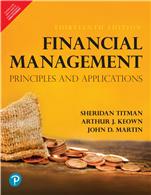Financial Management: Principles and Applications, 13/e

|
Author(s):
Author:
Sheridan Titman
- ISBN:9789353434885
- 10 Digit ISBN:9353434882
-
Price:Rs. 970.00
- Pages:720
- Imprint:Pearson Education
- Binding:Hardback
- Status:Available
-
|
Students often struggle to see how financial concepts relate to their personal lives and prospective careers. Financial Management: Principles and Applications gives students a big picture perspective of finance and how it is important in their personal and professional lives. Utilizing five key principles, the 13th Edition provides an approachable introduction to financial decision-making, weaving in real world issues to demonstrate the practical applications of critical financial concepts.
|
Table of Content
"Part 1: Introduction to Financial Management
1. Getting Started—Principles of Finance
2. Firms and the Financial Markets
3. Understanding Financial Statements
4. Financial Analysis—Sizing Up Firm Performance
Part 2: Valuation of Financial Assets
5. The Time Value of Money—The Basics
6. The Time Value of Money—Annuities and Other Topics
7. An Introduction to Risk and Return—History of Financial Market Returns
8. Risk and Return—Capital Market Theory
9. Debt Valuation and Interest Rates
10. Stock Valuation
Part 3: Capital Budgeting
11. Investment Decision Criteria
12. Analyzing Project Cash Flows
13. Risk Analysis and Project Evaluation
14. The Cost of Capital
Part 4: Capital Structure and Dividend Policy
15. Capital Structure Policy
16. Dividend and Share Repurchase Policy
Part 5: Liquidity Management and Special Topics in Finance
17. Financial Forecasting and Planning
18. Working-Capital Management
19. International Business Finance
20. Corporate Risk Management
"
|
Salient Features
Tying it all together. Through relevant, contemporary examples, students can easily identify relationships between the following key financial principles:
· Principle 1: Money has a time value.
· Principle 2: There is a risk-return tradeoff.
· Principle 3: Cash flows are the source of value.
· Principle 4: Market prices reflect information
· Principle 5: Individuals respond to incentives.
Getting the most out of the material. Essential Learning Aids help students understand concepts on a deeper level.
· Financial Analysis Tools provide quick reference guides for decision-making tools used in financial analysis. Appearing throughout the book, these helpful boxes display names, details, and summaries of calculations and formulas.
· Concept Checks give students chances to test themselves before moving on with two to five questions. These help clarify topics and make sure concepts are understood at the end of specific sections.
· A running glossary appears in the margins to define key terms found within each section.
· Finance in a Flat World boxes demonstrate how each chapter's content applies to international business, including the ongoing global financial crisis.
· Regardless of Your Major boxes, found at the beginning of each chapter, incorporate examples from other business school majors to show the wide range of applicability finance has to students and their career paths.
· The Business of Life boxes link important financial concepts to personal finance matters, helping students see key principles in action.
· Fundamental equations appear throughout each chapter so students can reference formulas for assignments and problems.
· Checkpoint Worked Examples allow students to assess their progress and knowledge at specific points throughout the text.
· Appendixes provide supplemental information on skills such as using a financial calculator and spreadsheet, and reading time value of money tables.
|
|
|
|
|